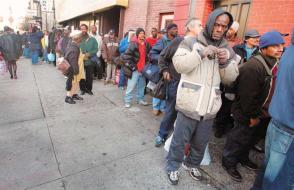Food stamps are the symbol of poverty in the US. In the era of the credit crunch, a record 28 million Americans are now relying on them to survive – a sure sign the world’s richest country faces economic crisis
We knew things were bad on Wall Street, but on Main Street it may be worse. Startling official statistics show that as a new economic recession stalks the United States, a record number of Americans will shortly be depending on food stamps just to feed themselves and their families.
Dismal projections by the Congressional Budget Office in Washington suggest that in the fiscal year starting in October, 28 million people in the US will be using government food stamps to buy essential groceries, the highest level since the food assistance programme was introduced in the 1960s.

Disadvantaged Americans queue for aid in New York
The increase – from 26.5 million in 2007 – is due partly to recent efforts to increase public awareness of the programme and also a switch from paper coupons to electronic debit cards. But above all it is the pressures being exerted on ordinary Americans by an economy that is suddenly beset by troubles. Housing foreclosures, accelerating jobs losses and fast-rising prices all add to the squeeze.
Emblematic of the downturn until now has been the parades of houses seized in foreclosure all across the country, and myriad families separated from their homes. But now the crisis is starting to hit the country in its gut. Getting food on the table is a challenge many Americans are finding harder to meet. As a barometer of the country’s economic health, food stamp usage may not be perfect, but can certainly tell a story.
Michigan has been in its own mini-recession for years as its collapsing industrial base, particularly in the car industry, has cast more and more out of work. Now, one in eight residents of the state is on food stamps, double the level in 2000. “We have seen a dramatic increase in recent years, but we have also seen it climbing more in recent months,” Maureen Sorbet, a spokeswoman for Michigan’s programme, said. “It’s been increasing steadily. Without the programme, some families and kids would be going without.”
But the trend is not restricted to the rust-belt regions. Forty states are reporting increases in applications for the stamps, actually electronic cards that are filled automatically once a month by the government and are swiped by shoppers at the till, in the 12 months from December 2006. At least six states, including Florida, Arizona and Maryland, have had a 10 per cent increase in the past year.
In Rhode Island, the segment of the population on food stamps has risen by 18 per cent in two years. The food programme started 40 years ago when hunger was still a daily fact of life for many Americans. The recent switch from paper coupons to the plastic card system has helped remove some of the stigma associated with the food stamp programme. The card can be swiped as easily as a bank debit card. To qualify for the cards, Americans do not have to be exactly on the breadline. The programme is available to people whose earnings are just above the official poverty line. For Hubert Liepnieks, the card is a lifeline he could never afford to lose. Just out of prison, he sleeps in overnight shelters in Manhattan and uses the card at a Morgan Williams supermarket on East 23rd Street. Yesterday, he and his fiancée, Christine Schultz, who is in a wheelchair, shared one banana and a cup of coffee bought with the 82 cents left on it.
“They should be refilling it in the next three or four days,” Liepnieks says. At times, he admits, he and friends bargain with owners of the smaller grocery shops to trade the value of their cards for cash, although it is illegal. “It can be done. I get $7 back on $10.”
Richard Enright, the manager at this Morgan Williams, says the numbers of customers on food stamps has been steady but he expects that to rise soon. “In this location, it’s still mostly old people and people who have retired from city jobs on stamps,” he says. Food stamp money was designed to supplement what people could buy rather than covering all the costs of a family’s groceries. But the problem now, Mr Enright says, is that soaring prices are squeezing the value of the benefits.
“Last St Patrick’s Day, we were selling Irish soda bread for $1.99. This year it was $2.99. Prices are just spiralling up, because of the cost of gas trucking the food into the city and because of commodity prices. People complain, but I tell them it’s not my fault everything is more expensive.”
The US Department of Agriculture says the cost of feeding a low-income family of four has risen 6 per cent in 12 months. “The amount of food stamps per household hasn’t gone up with the food costs,” says Dayna Ballantyne, who runs a food bank in Des Moines, Iowa. “Our clients are finding they aren’t able to purchase food like they used to.”
And the next monthly job numbers, to be released this Friday, are likely to show 50,000 more jobs were lost nationwide in March, and the unemployment rate is up to perhaps 5 per cent.
By David Usborne in New York
Tuesday, 1 April 2008
Source: The Independent
Fascinating….
https://www.youtube.com/watch?v=XibPKPACAvk#t=322